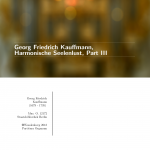
Georg Friedrich Kauffmann, Harmonische Seelenlust, Part III
Georg Friedrich Kauffmann (1679 - 1735), a German composer and organist, is the autor of the "Harmonische Seelenlust". This work, containing all of…
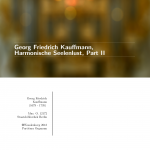
Georg Friedrich Kauffmann, Harmonische Seelenlust, Part II
Georg Friedrich Kauffmann (1679 - 1735), a German composer and organist, is the autor of the "Harmonische Seelenlust". This work, containing all of…

Georg Friedrich Kauffmann, Harmonische Seelenlust, Part I
Georg Friedrich Kauffmann (1679 - 1735), a German composer and organist, is the autor of the "Harmonische Seelenlust". This work, containing all of…
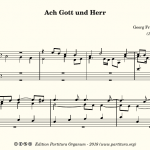
Georg Friedrich Kauffmann, Ach Gott und Herr
The last piece from the "Harmonische Seelenlust" that was composed by Kauffmann is a prelude to "Ach Gott und Herr". Obviously not meant as a grande…
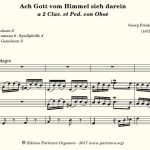
Georg Friedrich Kauffmann, Ach Gott vom Himmel sieh darein
The third prelude of Kauffmann's "Harmonische Seelenlust" that employs the oboe for the choral melody is as beautiful as the two I posted earlier.…
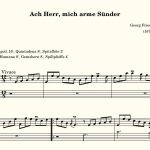
Georg Friedrich Kauffmann, Ach Herr mich arme Sünder
This melody is one of the most famous and most used of the Lutheran church. It is for example also used for "Wie soll ich dich empfangen", "Ach Herr…
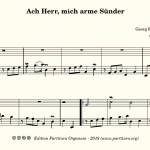
Georg Friedrich Kauffmann, Ach Herr, mich arme Sünder
Kauffmann's prelude to ``Ach Herr, mich arme Sünder'' is a simple yet attractive bicinium. Well, I say 'simple', writing an attractive simple…
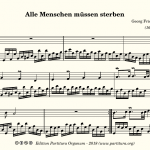
Georg Friedrich Kauffmann, Alle Menschen müssen sterben
Kauffmann's chorale prelude to "Alle Menschen müssen sterben" is a bicinium, with the choral melody in the right hand part, accompanied by rapid…
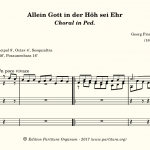
Georg Friedrich Kauffmann, Allein Gott in der Höh sei Ehr
When Kauffmann uses a ternary rythm, something special is the result. The prelude on "Allen Gott in der Höh sei Ehr" is no exception to that rule.…
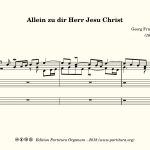
Georg Friedrich Kauffmann, Allein zu dir Herr Jesu Christ
Kauffmann's first prelude to "Allein zu dir, Herr Jesu Christ" is a small treasure of contrapuntal writing. It has the chorale melody in the bass…
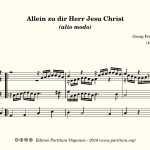
Georg Friedrich Kauffmann, Allein zu dir Herr Jesu Christ (alio modo)
Kauffmann's second chorale prelude to " Allein zu dir, Herr Jesu Christ" is even shorter than the fisrt one. Just 8 bars, whch are played twice. The…
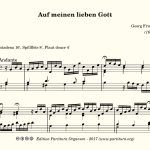
Georg Friedrich Kauffmann, Auf meinen lieben Gott
In the prelude to "Auf meinen lieben Gott" Kauffmann has the melody embellished in the soprano voice. Alto and bass provide a simple yet effective…
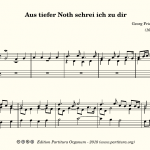
Georg Friedrich Kauffmann, Aus tiefer Noth schrei ich zu dir
Kauffmann's prelude to "Aus tiefer Noth schrei ich zu dir" is largely a manualiter piece. Setup as a fugato on the first phrase of the choral melody,…
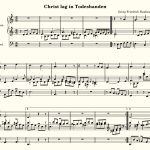
Georg Friedrich Kauffmann, Christ lag in Todesbanden
Georg Friedrich Kauffmann (1679 – 1735) was a Baroque composer and organist from southern Germany. He studied with Buttstett and Alberti. Later in…
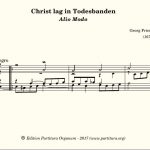
Georg Friedrich Kauffmann, Christ lag in Todesbanden (Alio Modo)
This is the twin prelude to a piece I uploaded almost two years ago. It uses just the first two phrases of the choral melody. But Kauffmann has them…
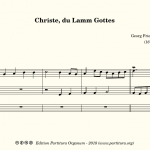
Georg Friedrich Kauffmann, Christe du Lamm Gottes
Kauffmann's prelude to "Christe, du Lamm Gottes" is another example of using a chorale melody as a bass line, to create a little trio for organ. The…

Georg Friedrich Kauffmann, Christus der uns selig macht
Kauffmann's prelude to "Christus der uns selig macht" is a is a simple yet effective bicinium. The soprano voice plays the chorale melody, the other…
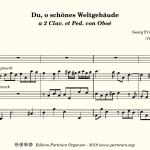
Georg Friedrich Kauffmann, Du o schönes Weltgebäude
Kauffmann's “Harmonische Seelenlust” contains six chorale preludes for the combination of organ and oboe. The oboe plays the chorale melody,…
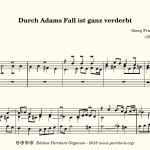
Georg Friedrich Kauffmann, Durch Adams Fall ist ganz verderbt
The last few chorale preludes from Kauffmann's "Harmonische Seelenlust" all have the same form of a fugato on the first phrase of the chorale melody.…
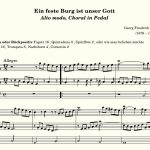
Georg Friedrich Kauffmann, Ein feste Burg ist unser Gott (2)
Kauffmann's second prelude on "Ein feste Burg ist unser Gott". It's a trio-like setting, with the melody in the pedals. The hands play a…
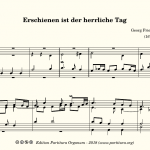
Georg Friedrich Kauffmann, Erschienen ist der herrliche Tag
Kauffmann's chorale prelude to "Erschienen ist der herrliche Tag" is a fugato play between the first two phrases of the chorale melody. Kauffmann…
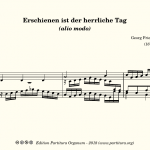
Georg Friedrich Kauffmann, Erschienen ist der herrliche Tag (alio modo)
Kauffmann's second chorale prelude to "Erschienen ist der herrliche Tag" has the chorale melody in the soprano voice. The other two voices weave a…
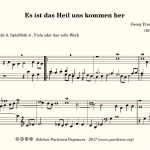
Georg Friedrich Kauffmann, Es ist das Heil uns kommen her
Kauffmann wrote two preludes to "Es ist das Heil uns kommen her". The first is a three part setting with the chorale melody in the soprano voice.…
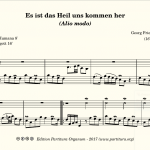
Georg Friedrich Kauffmann, Es ist das Heil uns kommen her (alio modo)
Kauffmann wrote two preludes to "Es ist das Heil uns kommen her". The second one is a nice bicinium. Kauffmann prescribes again a curious combination…
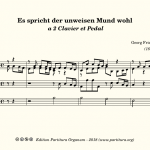
Georg Friedrich Kauffmann, Es spricht der unweisen Mund wohl
Kauffmann's prelude to ``Es spricht der unweisen Mund wohl'' is written for two manuals and pedal. It is however not immediately clear which part…
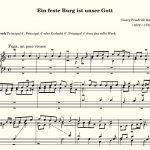
Georg Friedrich Kauffmann, Fuga über Ein feste Burg ist unser Gott
Kauffmann wrote two preludes on "Ein feste Burg ist unser Gott". They are both strong compositions, in which the greatness, reliability or…
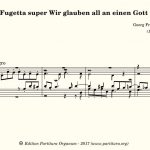
Georg Friedrich Kauffmann, Fughetta über Wir glauben all’ an einen Gott
Kauffmann's fughetta on "Wir glauben all' an einen Gott" is really short. Just 10 bars and that's it. It's a charming little piece nonetheless,…
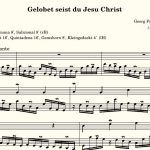
Georg Friedrich Kauffmann, Gelobet seist du Jesu Christ
Kauffmann's prelude on "Gelobet seist du Jesu Christ" is a bicinium. The registration Kauffmann prescribes that the left hand should probably be…
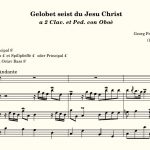
Georg Friedrich Kauffmann, Gelobet seist du Jesu Christ
Kauffmann seems to be the inventor of chorale prelude in which the chorale prelude is not played on the organ, but on a seperate instrument, in this…
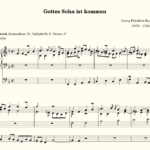
Georg Friedrich Kauffmann, Gottes Sohn ist kommen
An interesting prelude by Kauffmann on this Christmas choral. All phrases of the melody are introduces and accompanied by themselves in diminution.…
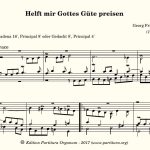
Georg Friedrich Kauffmann, Helft mir Gottes Güte preisen
Like in so many of his preludes Kauffmann prescribes the use of the Quintadena 16' for this piece. Since he gives an alternative registration, based…
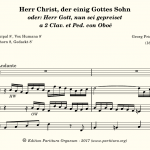
Georg Friedrich Kauffmann, Herr Christ, der einig Gottes Sohn
This is the fourth prelude in which Kauffmann employs the oboe to play the choral melody. The organ plays an elegant trio to accompany the oboe.…
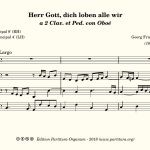
Georg Friedrich Kauffmann, Herr Gott, dich loben alle wir
This is the fifth prelude in which Kauffmann employs the oboe to play the choral melody. The organ plays an elegant trio to accompany the oboe.…
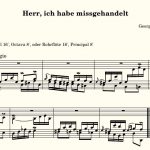
Georg Friedrich Kauffmann, Herr ich habe misgehandelt
In his registration prescriptions Kauffmann often uses a 16 feet stop. Sometimes that makes the music needlesly heavy to my ears. But in this piece…
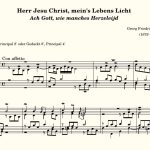
Georg Friedrich Kauffmann, Herr Jesu Christ mein’s Lebens Licht
Kauffman's is perhaps best remembered nowadays as author of "Die Harmonische Seelenlust", a complete edition of his organ chorales. He started…
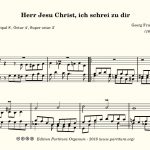
Georg Friedrich Kauffmann, Herr Jesu Christ, ich schrei zu dir
Kauffmann's prelude to "Herr Jesu Christ, ich schrei zu dir" is a relatively simple three part piece. The choral melody is in the upper voice. The…
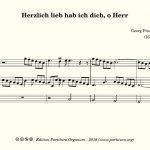
Georg Friedrich Kauffmann, Herzlich lieb hab ich dich, o Herr
Kauffmann's prelude to "Herzlich lieb hab ich dich, O Herr" is a trio with the choral melody in the pedals. As always when Kauffmann uses a ternary…
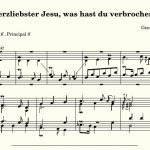
Georg Friedrich Kauffmann, Herzliebster Jesu, was hast du verbrochen?
Kauffmann's prelude on "Herzliebster Jesu was hast du verbrochen" is short but ingeniously constructed. It starts as a fugue on the first phrase of…
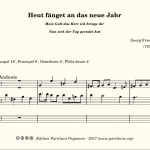
Georg Friedrich Kauffmann, Heut fänget an das neue Jahr
Kauffmann's prelude to "Heut fanget an das neue Jahr" is a cleverly constructed fugue. In the exposition the theme is (halfway) answered by its own…
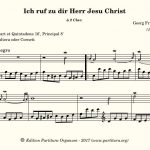
Georg Friedrich Kauffmann, Ich ruf zu dir Herr Jesu Christ
Kauffmann's prelude on "Ich ruf zu dir Herr Jesu Christ" is a bicinium. The choral melody is stated in half notes and accompanied by the rapidly…
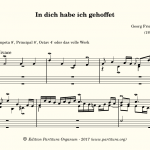
Georg Friedrich Kauffmann, In dich habe ich gehoffet
Kauffmann's first prelude to ``In dich habe ich gehoffet'' is a fugue on the first phrase of the choral melody. It is a cleverly constructued piece.…
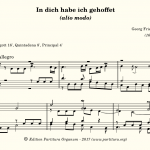
Georg Friedrich Kauffmann, In dich habe ich gehoffet (alio modo)
Kauffmann prescribes again a 16-feet reed for this choral prelude. I tried the combination he suggets, but it makes the music very heavy to my ears.…
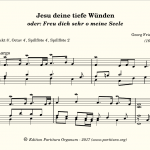
Georg Friedrich Kauffmann, Jesu deine tiefe Wünden
The melody of this choral is also known with the words "Freu dich sehr, o meine Seele". That seems an interesting contrafact, since based on the…
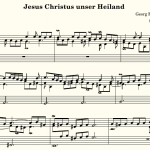
Georg Friedrich Kauffmann, Jesus Christus, unser Heiland
This Choral prelude on "Jesus Christus unser Heiland, der den Tod uberwand" is transcribed from a manuscript (Mus.ms. 22541 III) owned by the…
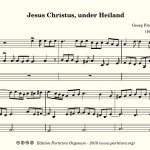
Georg Friedrich Kauffmann, Jesus Christus, unser Heiland
The source for most of the Kauffmann pieces is the original edition of 1733 of the "Harmonische Seelenlust". Some of the pieces can also be found in…
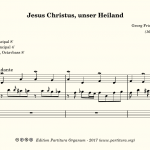
Georg Friedrich Kauffmann, Jesus Christus, unser Heiland.
Kauffmann's prelude to "Jesus Christus unser Heiland" is a magnificent Trio. The first phrase of the choral melody is combined with a chromatic…
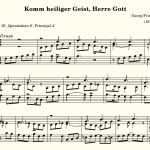
Georg Friedrich Kauffmann, Komm heiliger Geist, Herre Gott
The chorale prelude Komm heiliger Geist, Herre Gott was transcribed from from manuscript Mus.ms. 22541 III, owned by the Staatsbibliothek zu…
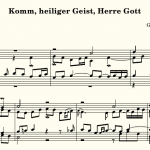
Georg Friedrich Kauffmann, Komm heiliger Geist, Herre Gott
The second prelude by Kauffmann on Komm heiliger Geist, Herre Gott in manuscript Mus.ms. 22541 III owned by the Staatsbibliothek zu Berlin The…
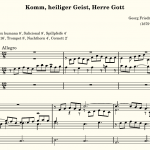
Georg Friedrich Kauffmann, Komm heiliger Geist, Herre Gott
The third choral prelude by Kauffmann on "Komm heiliger Geist, Herre Gott", found in manuscript Mus.ms. 22541 III owned by the Staatsbibliothek zu…
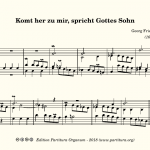
Georg Friedrich Kauffmann, Kommt her zu mir, spricht Gottes Sohn
Kauffmann's prelude to "Komt her zu mir, Spricht Gottes Sohn" is a very nice example of how to derive a musical piece from a choral melody. The…
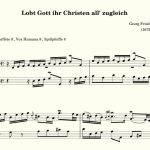
Georg Friedrich Kauffmann, Lobt Gott ihr Christen all’ zugleich
Kauffmann's prelude on "Lobt Gott ihr Christen all' zugleich" is a vivid three-part invention. The choral melody is presented in the middle voice,…
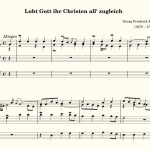
Georg Friedrich Kauffmann, Lobt Gott ihr Christen all’zugleich
The second prelude by Kauffmann on "Lobt Gott ihr Christen all'zugleich" is a much shorter work than the one I published almost two months ago. It is…
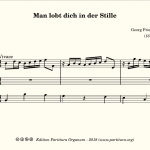
Georg Friedrich Kauffmann, Man lobt dich in der Stille
Kauffmann's prelude to ``Man lobt dich in der Stille'' is a lively, concertante work. The chorale melody is played against a fast paced accompaniment…
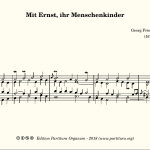
Georg Friedrich Kauffmann, Mit Ernst, ihr Menschenkinder
Kauffmann's prelude to "Mit Ernst, ihr Menschenkinder" is more a 4 part setting of the chorale melody, usable for as accompaniment for the…
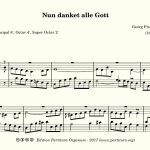
Georg Friedrich Kauffmann, Nun danket alle Gott
Kauffmann wrote two preludes on Nun danket alle Gott. They are both manualiter, well worked out pieces. The first one has the melody unadorned in the…
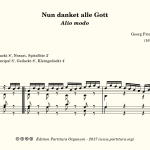
Georg Friedrich Kauffmann, Nun danket alle Gott (alio modo)
Kauffmann wrote two preludes on Nun danket alle Gott. They are both manualiter, well worked out pieces. The second one has the melody in the soprano…
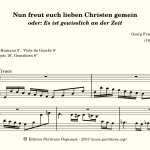
Georg Friedrich Kauffmann, Nun freut euch lieben Christen gemein
Kauffmann's prelude on "Nun freut euch lieben Christen gemein" is a lovely bicinium. The left had accompanies with scales and broken chords the…
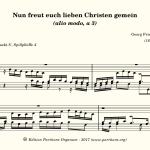
Georg Friedrich Kauffmann, Nun freut euch lieben Christen gemein (alio modo)
Kauffmann's second prelude on this chorale melody is a three part piece. The chorale melody in the soprano voice, the other two parts weave a…
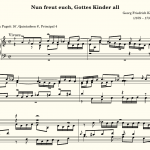
Georg Friedrich Kauffmann, Nun freut euch, Gottes Kinder all
The chorale prelude Nun freut euch, Gottes Kinder (found in manuscript Mus.ms. 22541 III, owned by the Staatsbibliothek zu Berlin) has the same…
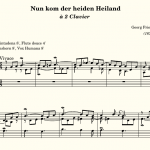
Georg Friedrich Kauffmann, Nun komm der Heiden Heiland
Manuscript Mus.ms. 22541 II (owned by the Staatsbibliothek zu Berlin - PK) contains 73 preludes based on chorales suitable for the Christmas period.…

Georg Friedrich Kauffmann, Nun komm der Heiden Heiland (2)
Manuscript Mus.ms. 22541 II (owned by the Staatsbibliothek zu Berlin - PK) contains four preludes by Kauffmann on "Nun kom der heiden Heiland". They …
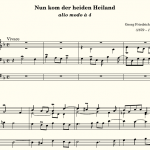
Georg Friedrich Kauffmann, Nun komm der Heiden Heiland (3)
The third prelude by Kauffmann on "Nun kom der heiden Heiland" in Manuscript Mus.ms. 22541 II (owned by the Staatsbibliothek zu Berlin - PK). It is a…
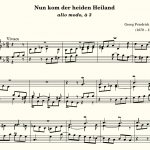
Georg Friedrich Kauffmann, Nun komm der Heiden Heiland (4)
This is the fourth prelude by Kauffmann, based on the prelude "Nun kom der heiden Heiland". In it's three part simplicity it is perhaps the most…
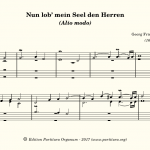
Georg Friedrich Kauffmann, Nun lob mein Seel den Herren
Kauffmann's second prelude on "Nun lob mein Seel den Herren" is a fugue on the first phrase of the chorale melody, though on a smaller scale than his…
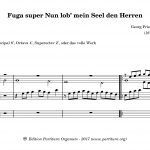
Georg Friedrich Kauffmann, Nun lob mein Seel’ den Herren
The chorale prelude on "Nun lob mein Seel' den Herren" is a fugue on the opening phrase of the choral melody. No frivolous registration this time,…
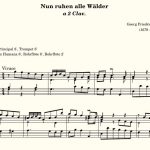
Georg Friedrich Kauffmann, Nun ruhen alle Wälder
Usually in choral preludes I tend to have stronger stops for the chorale melody and softer stops for the accompaniment. In this prelude, however,…
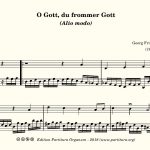
Georg Friedrich Kauffmann, O Gott du frommer Gott (alio modo)
Kauffmann's second prelude to " O Gott, du frommer Gott" is a relativly simple bicinium. Kauffmann does not give a registration prescription with…
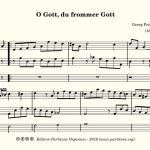
Georg Friedrich Kauffmann, O Gott, du frommer Gott
In the original publication Kauffmann's prelude to "O Gott, du frommer Gott" is notated on three staves. The choral melody is notated on the upper…
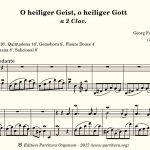
Georg Friedrich Kauffmann, O heiliger Geist, O heiliger Gott
Kauffmann's prelude on "O heiliger Geist, o heiliger Gott" calls for the almost impossible combination of a Quintadena 16' and Fagot 16' in the left…
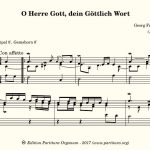
Georg Friedrich Kauffmann, O Herre Gott, dein Göttlich Wort
Kauffmann wrote three preludes to the choral "O Herre Gott, dein Göttlich Wordt". Or perhaps I should say "two and a half" since the third one is…
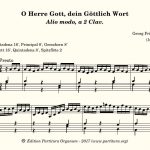
Georg Friedrich Kauffmann, O Herre Gott, dein Göttlich Wort (Alio modo)
Again a piece with an unusual registration prescription. No indication however which hand should play on which manual. So I made two recordings.…
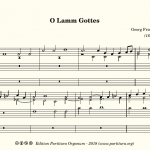
Georg Friedrich Kauffmann, O Lamm Gottes
The intended structure of Kauffmann's prelude to "O Lamm Gottes" is not immediately clear. Kauffmann gives an alternative ending for the piece that…
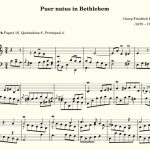
Georg Friedrich Kauffmann, Puer natus in Bethlehem
The Staatsbibliothek zu Berlin has at least three sources for this prelude by Kauffmann: two copies of "Der Harmonische Seelenlust" and the…
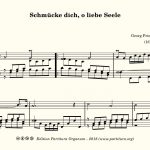
Georg Friedrich Kauffmann, Schmücke dich, o liebe Seele
Kauffmann's prelude to "Schmücke dich, o liebe Seele" has the choral melody in the upper voice. The other two voices are never far apart and can be…
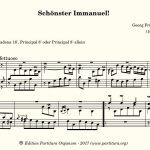
Georg Friedrich Kauffmann, Schönster Immanuel
In this choral prelude Kauffmann again prescribes the use of the Quintadena 16'. Together with the Praestant 8' it forms an interesting combination I…
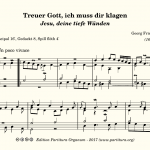
Georg Friedrich Kauffmann, Treuer Gott ich muss dir klagen
Kauffmann's prelude to "Treur Gott ich muss dir klagen" is a bit of a challenge for the listener. The choral melody is well hidden in the tenor voice…
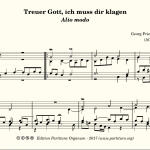
Georg Friedrich Kauffmann, Treuer Gott, ich muss dir klagen (alio modo)
This is the twin prelude to the one I uploaded two days ago. This time the choral melody is more easily discernible, as it is played in the soprano…
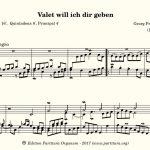
Georg Friedrich Kauffmann, Valet will ich dir geben (1)
Kauffmann's first prelude on "Valet will ich dir geben" calls for a combination that I by now consider as 'typically Kauffmann': Fagott 16',…
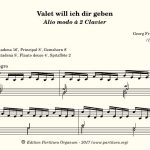
Georg Friedrich Kauffmann, Valet will ich dir geben (alio modo)
Kauffmann's second prelude to the melody of chorale "Valet wil ich dir geben" is again a piece with an unusual registration prescription. No…
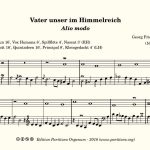
Georg Friedrich Kauffmann, Vater unser im Himmelreich (alio modo)
Kaufmann wrote three choral preludes to "Vater unser im Himmelreich". The second is a bicinium, with the choral melody in the soprano voice. The…
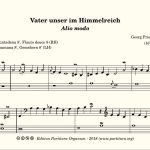
Georg Friedrich Kauffmann, Vater unser im Himmelreich (alio modo)(2)
Kaufmann wrote three choral preludes to "Vater unser im Himmelreich", two of which are bicinia. This is the second bicinium, with the chorale melody…
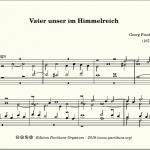
Georg Friedrich Kauffmann, Vater unser im Himmelreich (Fuga)
Kaufmann wrote three choral preludes to "Vater unser im Himmelreich". The first is a powerfull 4-voice fugue on the first phrase of the chorale…
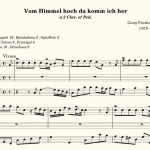
Georg Friedrich Kauffmann, Vom Himmel hoch da komm ich her
Another go at this choral melody, this time by Kauffmann. It is intruiging how one melody can give rise to so many different pieces. This version is…
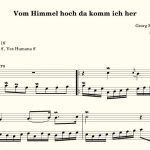
Georg Friedrich Kauffmann, Vom Himmel hoch da komm ich her (2)
Kauffmann is best known for the "Harmonische Seelenlust". This work, containing all of his known chorale preludes together with figured bass settings…
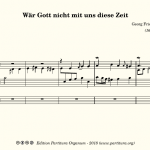
Georg Friedrich Kauffmann, Wär Gott nicht mit uns dieser Zeit
Kauffmann's prelude to "Wär Gott nicht mit uns dieser Zeit" is written like a Trio for organ, with the choral melody as bass voice. The other two…
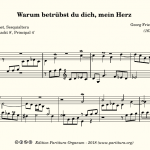
Georg Friedrich Kauffmann, Warum betrübst du dich mein Herz
Kauffmann's prelude to "Warum betrübst du dich, mein Herz" is a slow paced three part piece. Kauffmann prescribes both Cornet and Sesquialetra for…
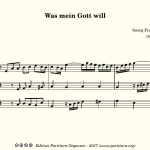
Georg Friedrich Kauffmann, Was mein Gott will
Kauffmann's prelude to "Was mein Gott will" is his most rhapsodic or improvisatory prelude. Four different ideas, from fast trio writing to adagio…
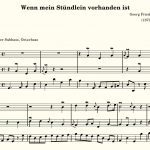
Georg Friedrich Kauffmann, Wenn mein Stündlein vorhanden ist
This chorale prelude was transcribed from manuscript Mus. ms. 22541 III owned by the Staatsbibliothek zu Berlin. Kauffmann prescribes a Gemshorn 8'…
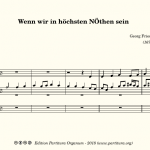
Georg Friedrich Kauffmann, Wenn wir in höchsten Nöthen sein
Kauffmann's prelude to "Wenn wir in höchsten Nöthen sein" is again a fugato with the first phrase of the chorale melody as theme. Though notated on…
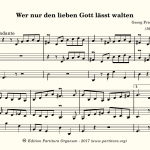
Georg Friedrich Kauffmann, Wer nur den lieben Gott lässt walten
Kauffmann's 'Harmonische Seelenlust' contains three preludes to "Wer nur den lieben Gott lässt walten". Only one of them was written by Kauffmann.…
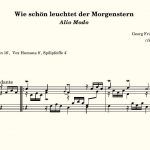
Georg Friedrich Kauffmann, Wie schön leuchtet der Morgenstern
Kauffmann wrote two preludes to the choral "Wie schön leuchtet uns der Morgenstern". For the organ solo one, Kauffmann prescribes the use of a…

Georg Friedrich Kauffmann, Wie schön leuchtet der Morgenstern
This prelude is one of the six Kauffmann wrote for the combination organ and oboe. It is a lively piece in 6/8 meter. Kauffmann has a knack for…
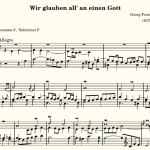
Georg Friedrich Kauffmann, Wir glauben all an einen Gott
Transcribed from manuscript Mus.ms. 22541 III owned by the Staatsbibliothek zu Berlin The recording was done with the sampleset, made by Organ Art…
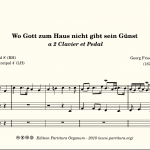
Georg Friedrich Kauffmann, Wo Gott zum Haus nicht gibt sein Gunst
Kauffmann's chorale prelude to "Wo Gott zum Haus nicht gibt sein Gunst" is a nice example of Trio writing, with the chorale melody in the bass…
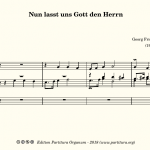
Kauffmann/Zachow, Nun lasst uns Gott den Herrn (LV 39)
Kauffmann's prelude to "Nun lasst uns Gott den Herrn" is actually not by Kauffmann at all, but is a piece composed by Friedrich Wilhelm Zachow.…
Visits: 7636
